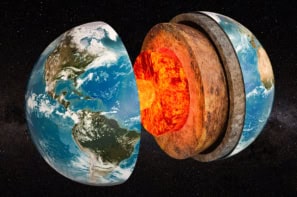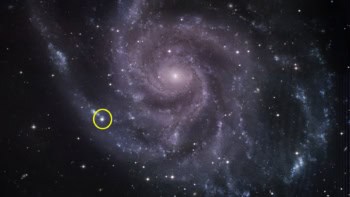
A compelling alternative explanation for what astrophysicists believe is the largest black hole merger measured to date has been put forth by two astronomers in Germany. Alexander Nitz and Collin Capano at the Max Planck Institute for Gravitational Physics argue that the gravitational wave GW190521 created by the merger could have been triggered by a stellar-mass black hole spiralling into a far larger body. If correct, their results could resolve a mystery surrounding the masses of both bodies in the merger and may lead to a better understanding of intermediate-mass black holes.
In May 2019, the LIGO and Virgo observatories detected gravitational waves originating from a black hole merger that created a new body weighing in at about 140 solar masses – making this the largest black hole merger seen so far. Subsequent calculations showed that the two black holes responsible for the GW190521 signal measured roughly 85 and 66 solar masses. Yet these values seem to be at odds with our current understanding of stellar evolution.
When giant stars of about 65–120 solar masses explode as supernovae, current theories predict that the explosions completely overwhelm the gravity holding the star together. As a result, no material is left behind after the explosion – not even a black hole. This should create a gap in the mass range of black holes formed from exploding stars, however both objects involved in the GW190521 merger appear to fall inside this gap.
Fine tuning
To extract information about black hole masses from gravitational waves, astronomers must compare their observations to theoretical models, which incorporate prior assumptions about the physics. By selecting different priors and constraints, researchers can fine-tune their models to better fit their observations. In their study, Nitz and Capano used a different set of priors to assess the GW190521 signal than those originally used by LIGO–Virgo scientists.

LIGO–Virgo spots its most massive black hole merger so far
The duo’s work yielded two possible solutions. In the first, both masses were like those originally calculated by LIGO–Virgo. In the second, however, they fell well beyond the forbidden mass gap to either side: measuring roughly 166 and 16 solar masses. The heavier object would be an intermediate-mass black hole, which are thought to form not in supernovae, but by black holes devouring matter or even other black holes. These currently-elusive bodies lie between those formed by collapsed stars, and the supermassive black holes at the centres of galaxies – which can be millions or billions of times more masive than the Sun.
If Nitz and Capano’s interpretation is correct, it could not only resolve the mass gap mystery; it would also make the GW190521 merger the first detected example of a stellar-mass body spiralling into an intermediate-mass black hole. Therefore, the duo’s results may offer compelling new clues about their properties of intermediate-mass objects and could enable astronomers to describe a greater variety of black hole mergers from future detections of gravitational waves.
The research is described in The Astrophysical Journal Letters.



